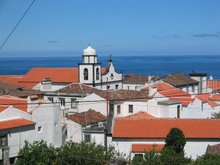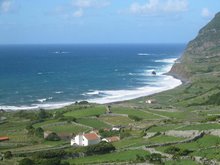The 2012 autumn equinoctal gales left our vine frame thing (there's another example of where there's probably a neat Portuguese word with no equivalent in English) at an odd angle. That's subsequently been renovated thanks to João. It also blew a few cumes (roof ridge tiles) away and these were replaced thanks to Vitor. I'll just add my thanks again to João and Vitor - thanks guys.
The 2013 spring equinoctal gales have just finished. The thing about the wind this time was it came from the east which means that, instead of roaring steadily off the sea, it comes down off the mountains in vicious gusts. It's silence punctuated unpredictable short blasts which make you think "I wonder what that one destroyed". Fortunately for us, it was only the disclocation of a few more cumes (since replaced by Vitor again) and a tree (more of a "big bush" said in a Rowan Atkinson tone of voice) in the garden being blown down. But, of course, the plane couldn't land for several days in a row and also the ship couldn't call at Lajes as witness below - note all the cack blown out of the sea on to the hard:-
 I should explain that the vessel in that pic is not the ship which brings our supplies and couldn't berth. It's the vessel that takes supplies out to our satellite island of Corvo. It remains moored in the harbour at Lajes and I can tell you from analogous nautical cove experiences in a past life that, if I had an insurable interest in that boat, watching its moorings straining in the breeze, my punders would need to have been put through the "heavy soil" cycle of the washing machine (with extra rinse).
I should explain that the vessel in that pic is not the ship which brings our supplies and couldn't berth. It's the vessel that takes supplies out to our satellite island of Corvo. It remains moored in the harbour at Lajes and I can tell you from analogous nautical cove experiences in a past life that, if I had an insurable interest in that boat, watching its moorings straining in the breeze, my punders would need to have been put through the "heavy soil" cycle of the washing machine (with extra rinse).But the really remarkable thing about this spring's equinox was the torrential rain. It didn't stop (not a break between showers) for about five days. On this peaky island, the danger that brings is not floods (because the water drains away quickly) but landslides. At particular risk here is a stretch of the road from Faja Grande out to the rest of the island which passes up the side of a steep hill. Below is what I'm talking about from 3D Google Earth:-
Not sure how expressive that is but below is when we were stopped in the car at the bottom of the hill at about point X for 20 minutes or so while the road gang cleared away trees and rocks which had fallen ahead with a combination of JCBs and chain saws:-
Of course, the photo never does the experience credit but the rain was just frighteningly torrential. I give all credit to the road gang for their speed of response. The fact is Flores is geared up to respond quickly to the consequences of heavy rain in a way that Britain is not equipped to respond to half an inch of snow.
But much as they respond quickly and we've never been delayed longer than 10-20 minutes or so, I've seen myself turn back in really wet weather rather than risk being cut off from home by what is the only road to Faja Grande being closed by a really bad landslide which it would take more than a few hours to clear. But until today, I'd always assumed the risk would be a pile of cack falling on the road from above. Not the road itself sliding off down the hill:-
That's at about point Z on the GE image this afternoon after the rain had stopped. It goes without saying that I shouted to Carol to get out of the car to come and join me in jumping up and down to see if we could get it to shake underneath us. But she spoils all my fun ("Get back in the car NOW and drive hard up on the right hand side!")
I'm glad I'm a lawyer and not a road engineer! How on earth do you repair that? Will take a bit more than a bit of Polyfilla, I think. I'm going to be watching and learning, though, and will keep you posted.










No comments:
Post a Comment